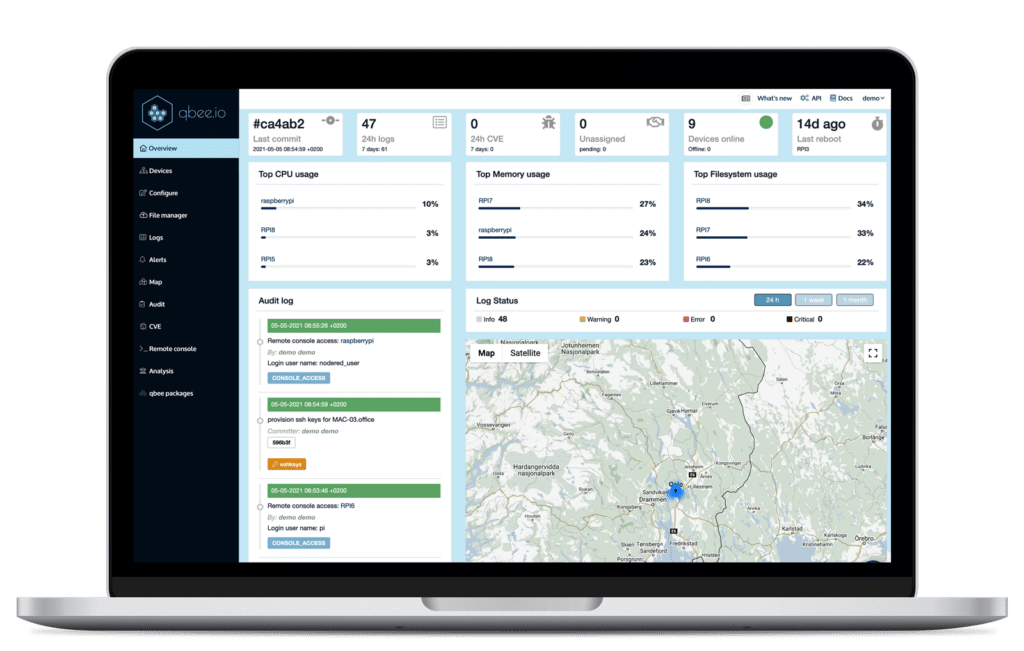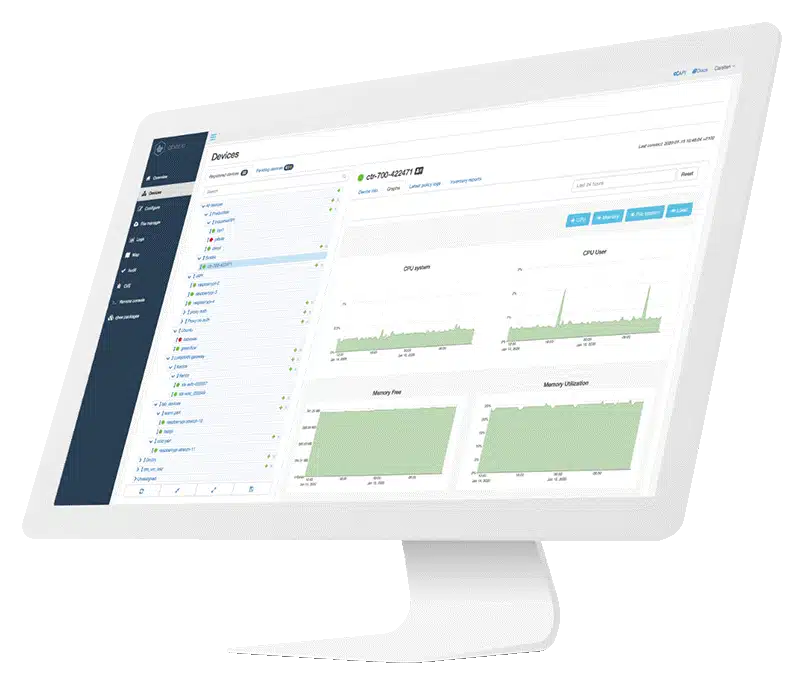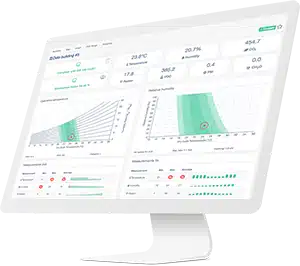The following use case study was first published on Marktplatz I4.0 in German and showcases how qbee AS, a member of the industry 4.0 initiative, helps facility management companies monitor and operate their smart buildings more efficiently and in an environmentally friendly manner through remote device management and remote access.
How does qbee.io help with smart buildings?
A large facility management company wanted to improve the energy efficiency and environmental friendliness of their property portfolio by turning their facilities into smart buildings with the help of wireless sensors. The aim was to gain a detailed overview of the indoor climate in both new and old office buildings to identify energy efficiency measures to reduce each building’s energy footprint. All sensors and receiving gateways had to be installable by building managers to save installation costs, with the operation of the application software and edge gateways controlled centrally.
The project was delivered by Greenflow AS, and comprised the following components:
- Cloud IoT platform Tingsense
- Multi sensor system & 4G edge gateways (an industrial Raspberry Pi) with wireless measurements of CO2, temperature, humidity, light and noise level
- Embedded Linux device management and remote access software qbee
You can also find a general overview over what features qbee offers for smart buildings in the link.
A Service Level Agreement is only as good as the weakest component in the technology stack
To ensure the planned service level agreement (SLA) could be reached, a smart remote device management system was required to reduce errors and downtime. Qbee became a central part of the smart building architecture, providing both remote access and device management. To avoid any potential sources of error, it was decided to rely on 4G cellular connectivity for gateway-to-server communication, thus excluding the smart building’s own network.
An IoT platform for smart building and facility management that monitors indoor climate
All smart buildings deliver their sensor data to the IoT visualization platform Tingsense. Within Tingsense, different climate zones can be defined, and wireless sensor data can be assigned to areas, floors, and buildings, allowing for granular insight into indoor climate conditions. The platform contains a PMV (predictive mean vote) / PPD (percentage people dissatisfied) model, which derives the control parameters for the climate control from extensive studies of human perception of temperature in relation to humidity, clothes, metabolic activity, and HVAC air flow in the areas. By comparing energy consumption across buildings and correlating it with the quality index, the energy efficiency and indoor climate quality can be compared, ensuring that energy efficiency is achieved through smart regulation of the components in the HVAC rather than compromising indoor climate quality.
In addition to aggregated analyses of areas or floors it is also possible to get detailed insights on a per sensor level to see irregularities, analyze patterns and generate additional insight. Below is a Tingsense IoT platform dashboard visualizing a single sensor:
Why do you need IoT edge device management and remote access?
Qbee’s IoT device management platform for embedded Linux edge devices allows for easy installation of edge gateways and wireless sensors by facility managers, which can then operate reliably throughout the lifecycle of the smart building or facility management system. This platform securely connects to the qbee backend in the cloud, and can run on any Linux device, allowing for easy connection of older and existing units into the IoT device management platform. The OTA software update functionality of qbee allowed Greenflow AS to test the gateways and sensors both in the lab and on premise at the customer site, allowing for quick progress and milestones.

Receiving data from real buildings early in the project was very helpful, and Greenflow AS was able to constantly show the customer progress and milestones through the OTA software update functionality of qbee.
What features does an edge device management solution cover?
In this project qbee is used to cover the following areas:
- OTA software updates of the OS and application software
- Configuration management to configure the Linux operating system
- Parametrization of the application software (MQTT data broker)
- Remote access for analysis and debugging
- Monitoring of the edge device performance
- CVE vulnerability analysis and continuous monitoring
- Monitoring of edge gateway functionality
- Watchdog for the 4G cellular USB modem
The key driver for the selection of qbee in this use case was the remote device access functionality. But in the end most of qbee’s features were used and the customer was positively surprised how many value adding functions the tool offers. That is why we often refer to qbee as the “swiss army knife for embedded Linux systems”.
The remote edge gateways installed in the buildings automatically deploy important software updates, including for the operating system and application software. This over-the-air (OTA) update is critical to the system’s operation. Additionally, a CVE vulnerability analysis continuously compares all package libraries with entries in the NIST CVE database, proactively identifying and updating libraries with vulnerabilities as soon as a patch becomes available. The built-in state-based configuration engine enables easy Linux OS housekeeping, including user and password management, NTP server configuration, ssh key rotation, and firewall configuration to close all ports, since all remote device access works through the qbee built-in VPN. Using a pull-based architecture, the agent can communicate through any firewall, NAT, or cellular network without needing to know the device or building’s IP address. Installing and bootstrapping the pre-compiled agent package immediately enables remote ssh access through the web interface and qbee-connect desktop application for Windows, MacOS, and Linux. This secure solution even allows for ssh port forwarding of other closed devices in the local network, as well as access to any port or service (http, https, Node-Red, VNC, SCADA Systeme).
Metric data collected from devices, including CPU load, memory consumption, and consumed bandwidth, are visualized on a dashboard, enabling efficient development and operational monitoring. Memory leaks and log creeping are easily identified, and offline devices are immediately flagged with a warning.

The gateway solution includes an industrial Raspberry Pi from Techbase with a built-in cellular USB modem for 4G connectivity, as well as proprietary sensors connected through a radio module utilizing the USB bus of the device. Qbee’s smart watchdog functionality ensures seamless device management, even if there are cellular connectivity provider issues by restarting and power cycling the cellular USB modem in case of problems.
The application on the gateway communicates through MQTT with the Tingsense cloud, allowing Greenflow to control different MQTT broker settings on a group or device level through software parametrization and templating. This makes the solution scalable for multiple customers and enables system operators to monitor different fleets of devices for various customers through a single system and dashboard.
If you need help with embedded device management and remote device access, Qbee is available to consult and provide support for the complete device lifecycle. Try our 30-day free trial or contact us for a quick demo and to discuss your use case.
Focus on your core business area and competency while we help manage and monitor your devices.









